Flowers Native to Greece You Can Grow Locally
Ever browsed the internet and came across a Greek garden? They are the definition of perfection, and the flowers in them are stunning; you can just imagine how beautiful the scent is.
Native Greek flowers are associated with a lot of myths that ancient Greeks passed on from one generation to another.

So what are the most popular flowers of Greece and what are the myths the natives of Greece believe about them? Keep reading to find out!
Related Article:
9 Native Greek Flowers and the Myths Behind them
#1. Hyacinth

These bell-shaped bulb flowers come in shades of lavender, blue, purple, pink, yellow, white, and red.
According to Greek mythology, Hyacinths are associated with the tears of the sun god. He and Zephyrus, the west wind loved and admired the handsome Spartan prince Hyacinth.
However, Hyacinth’s attention was on Apollo, and thus, when they were throwing discus, Zephyrus blew the discus and it struck Hyacinth killing him instantly.
When Apollo saw that his lover was dead, he wept, and where his tears landed, the beautiful hyacinth flowers sprouted.
For the best result, plant your hyacinths in a sunny area with a partial shade. The soil should be moderately fertile, and you should loosen it before planting the bulbs.
Hyacinths are not water tolerant; thus, choose a spot where water does not collect since they rot when exposed to too much moisture.
When taking care of your hyacinth flowers, ensure you use gloves. Hyacinths produce a substance that can irritate your skin and cause itching.
#2. Daffodils
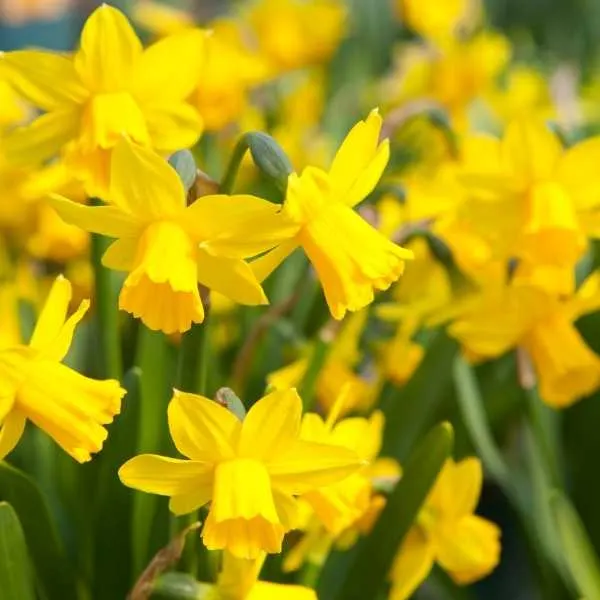
There are many types of daffodils suited for various climates. While some require a period of cold winter weather to blossom, others thrive well in warmer areas.
The traditional daffodil flower was yellow and white with six petals and a trumpet-shaped center. However, today they exist in pink, white, yellow, peach, and even orange!
Who knew that such beautiful flowers gave rise to the term narcissist? Daffodils are also known as narcissus. They are associated with Narcissus, who many girls in his village admired, but he was so self-centered to notice.
However, after breaking Echo’s (a nymph who went to live in caves, never to be seen again) heart, Nemesis, god of revenge, punished him. She lured him to a pond where he drowned after falling in love with his reflection.
Where he sat admiring himself, the narcissus flowers sprouted, representing selfishness and cold-heartedness.
Plant your daffodils in the fall before the ground freezes in fertile soil with good drainage. Daffodils also require at least 6 hours of sunlight and a temperature of 60 degrees Fahrenheit for beautiful blooms.
One great thing about Daffodils is that they produce oxalic acid, which makes daffodils unpalatable to rodents.
But, the downside of this substance is that it causes itching, so handle them with gloves.
#3. Gladiolus
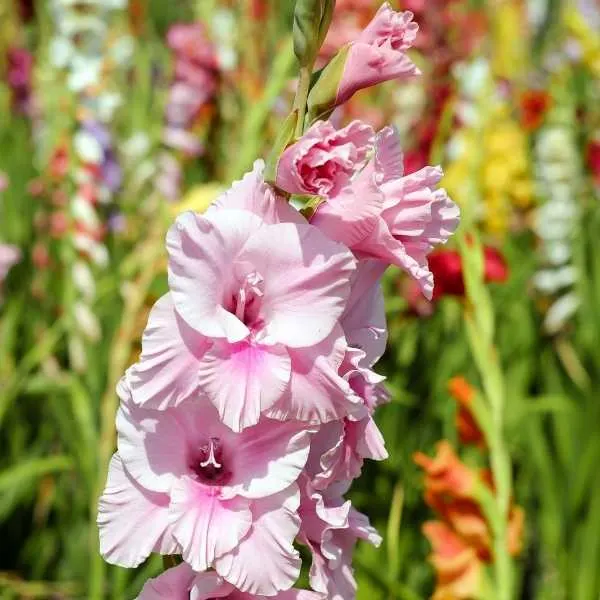
Unlike the flowers we have discussed above, the gladiolus is not bulb flowers, but rather corms are used for propagation.
They range from 2 to 5 feet in height—additionally, the colors range from white, yellow, lavender, green, and even burgundy.
The name gladiolus can be traced back to the Greek term for a sword. They named it so due to its tall spikes and narrow leaves that closely resemble a sword.
The good news is that gladiolus, commonly known as Glads, is a low maintenance flower that you can plant and maintain easily in your garden. All they need is moderately fertile soil and good drainage. The temperature should be around 55 degrees Fahrenheit.
If you are planting glads primarily to cut flowers, plant them in rows since rows make it easier to tend the garden and cut flowers.
Ensure you water your plant if you are in an area with inadequate rainfall. Additionally, cover the base with mulch or hay for water retention and protection against strong winds.
When cutting the flowers, cut those with unopened buds as they will open on their own when put in a vase containing water.
#4. Anemone
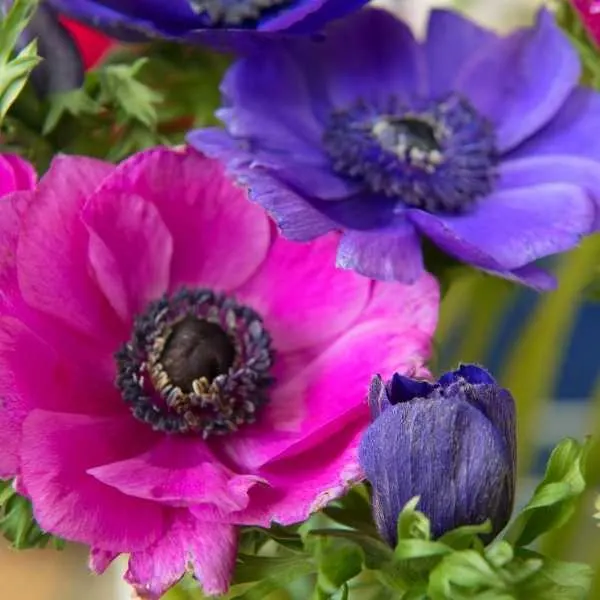
Anemones are propagated through corms. The corms should be planted 6 inches in flower beds of 5 rows each. The white, red, blue, and purple flowers grow after three water weeks from when you plant them, and they continue to bloom for up to 10 weeks. When it gets colder, you should cover your anemones with a layer of frost cloth to protect them.
Like most Greek flowers, anemones are associated with the death of Adonis, the lover of Venus, goddess of love. According to Greek mythology, when Venus heard her lover’s cries, she rushed to his side only to witness him bleeding to death due to an attack by a wild boar.
As his droplets of blood touched the ground, red anemones grew. According to another version the anemones were white and turned red upon Adonis blood dropping on them.
#5. Dianthus

These flowers are commonly referred to as carnations, and the most common myth involves Artemis, goddess of the hunt. After an unsuccessful hunt, Artemis came upon a man playing the flute, and due to her anger, she blamed his music for her failed hunt.
She then gouged his eyes, but when her rage subsided, she realized what she had done. She was filled with so much remorse that red carnations grew as a sign of innocent blood where she dropped the eyes.
To grow these flowers, purchase quality seeds and planting pots. Put soil in the pots and press the seeds into the soil. Do not cover the seeds with too much soil, and ensure you water them well. Ensure that the soil is fertile and has good drainage.
#6. Christmas Rose

Unlike most flowers in this list, Christmas roses, also known as hellebore, bloom in the winter. Thus they do not even require much care, all they need is water, and as long as their roots are strong, your garden will not be bare in winter.
In Greece, these flowers are believed to cure gout, insanity, and paralysis.
#7. Iris

Iris is the Greek god of colors and rainbow. According to ancient Greek mythology, Iris used the rainbow as a bridge between heaven and earth, while others thought it was part of her robe or multicolored veil.
Whichever the case, the purple, blue, pink, yellow, and red flowers make a beautiful addition to a garden. The purple iris is one of the purple flowers that bloom in spring.
For best results, plant iris in a sunny spot as they require 6 hours of sun. Do not plant them so close together since irises bloom well when they have enough room to thrive.
Lastly, make a habit of dividing them, and your iris will always be beautiful.
#8. Lilies
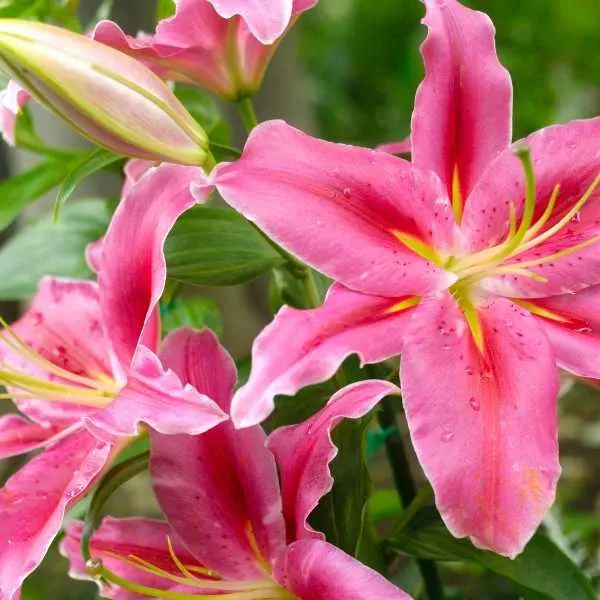
There are various shades of lilies, but the most common are white and pink. To get big beautiful lily flowers, choose large, firm bulbs and plant them in loosened fertile soil.
Additionally, if you are in an area that experiences harsh winter conditions, ensure that your lily bulbs are beneath 12 inches of soil.
Lilies are associated with Hera’s milk in Greek mythology. Her husband, Zeus, the god of thunder and lightning had an affair with a mortal that led to the birth of Hercules.
However, Zeus knew that Hera’s breast milk was the best for raising gods; thus, he drugged her to sleep. But Hera woke up as the child suckled and flung him away. As her breast milk touched the earth, the lilies sprouted.
#9. Aster
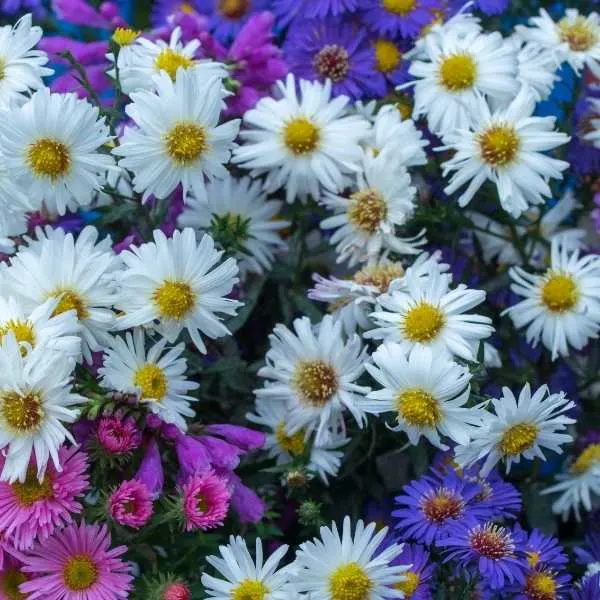
If you haven’t guessed it yet, this flower gets its name from the star. The purple, pink, white, red, and blue flowers are star-shaped and easy to plant and maintain.
They grow well in the sun, and if you grow them in the shade, they won’t produce as many flowers. Additionally, ensure that you plant them in well-drained loamy soil.
There are two various Greek myths concerning asters. The most common myth is about Astraea, the goddess of justice, innocence, and purity.
According to this mythology, when Zeus decided to destroy the world with flood because of wars among men, Astraea was saddened, and she wished to become a star.
Her wish was granted, but as she saw the loss of lives from the sky, she was saddened and cried. And beautiful asters sprouted at every spot her tears landed on the earth.
Native Flowers of Greece – Conclusion
There you have it. Enjoy your gardening as you add those native Greek flowers to your garden and watch them come to life! You can even grow these native flowers of Greece on a large scale to sell and generate a nice income.
Related Articles:

